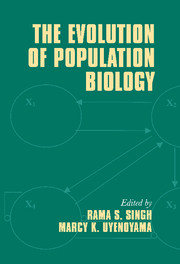Book contents
- Frontmatter
- Contents
- List of contributors
- Publications of R. C. Lewontin
- Preface
- Introduction
- Part I Historical foundations and perspectives
- Part II Genotypes to phenotypes: new genetic and bioinformatic advances
- Part III Phenotypes to fitness: genetics and ecology of populations
- Part IV Genes, organisms, and environment: evolutionary case studies
- Part V Applied population biology: biodiversity and food, disease, and health
- 17 Conservation biology: the impact of population biology and a current perspective
- 18 The emergence of modern human mortality patterns
- 19 Units of selection and the evolution of virulence
- 20 Evolutionary genetics and emergence of RNA virus diseases
- 21 A scientific adventure: a fifty years study of human evolution
- 22 Geneticists and the biology of race, 1900–1924
- Index
19 - Units of selection and the evolution of virulence
Published online by Cambridge University Press: 08 January 2010
- Frontmatter
- Contents
- List of contributors
- Publications of R. C. Lewontin
- Preface
- Introduction
- Part I Historical foundations and perspectives
- Part II Genotypes to phenotypes: new genetic and bioinformatic advances
- Part III Phenotypes to fitness: genetics and ecology of populations
- Part IV Genes, organisms, and environment: evolutionary case studies
- Part V Applied population biology: biodiversity and food, disease, and health
- 17 Conservation biology: the impact of population biology and a current perspective
- 18 The emergence of modern human mortality patterns
- 19 Units of selection and the evolution of virulence
- 20 Evolutionary genetics and emergence of RNA virus diseases
- 21 A scientific adventure: a fifty years study of human evolution
- 22 Geneticists and the biology of race, 1900–1924
- Index
Summary
Introduction
In his classic paper on the units of selection Richard Lewontin, following Williams (1966), emphasized that natural selection for characteristics that benefited individual organisms was stronger than selection for characteristics that benefited groups of organisms. One of the most important generalizations from this insight is that natural selection will tend to favor characteristics that benefit the survival and reproduction of individuals (individual selection) over characteristics that benefit group survival or productivity (group selection) when these two benefits are contradictory (Williams 1966, Lewontin 1970). Lewontin went on to suggest that group selection might be particularly strong for parasites because the parasites within a host are a well-defined group and the transmission of such groups may be highly dependent on the characteristics of the group, such as the overall level of harm that the group of parasites imposes on the host; consequently if one wishes to evaluate whether group selection is important in nature, parasites would be appropriate objects for study (Lewontin 1970).
One reason for this expectation derives from the theory of inclusive fitness, which emphasizes how characteristics that benefit other group members can be favored even when they impose a cost on the individual possessing the characteristic as a result of the positive effects of the characteristic on other individuals that harbor the same genetic instructions (Hamilton 1964).
- Type
- Chapter
- Information
- The Evolution of Population Biology , pp. 377 - 390Publisher: Cambridge University PressPrint publication year: 2004
- 2
- Cited by



